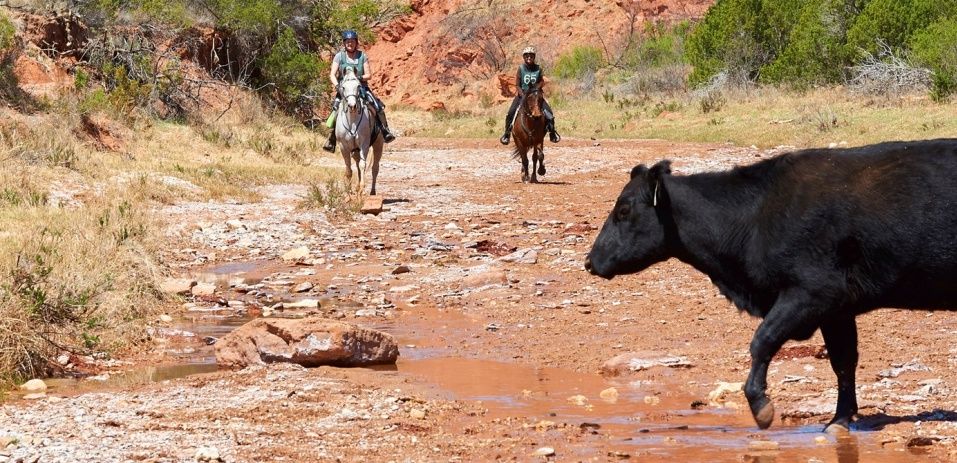
By Bev Roberts
Strategy in CTR? You bet! For six months now, we have been discussing strategies for competing with the least stress and most enjoyment. We’re still out on the trail handling all the things mother nature, ride officials and other competitors present to us. Safety is part of a successful ride strategy.
You are not alone. (Sounds ominous… doesn’t it?) You may encounter all sorts of people and other creatures.
Veterinary Judge. Besides the folks at obstacles and pulse and respiration checks, the veterinary judge and the secretary will stop you a couple of times to perform a metabolic check on “Old Dobbin” to assess how your horse is handling the trail work and advise you on what to keep an eye on, if anything.

Most horses welcome the opportunity to stop and relax. For safety’s sake (vets want to live to see another day), for good manners (no trampling allowed) and for accurate readings, savvy riders teach their horses to stand quietly. You horse has to tolerate an eyelid being lifted, lips separated, gums pressed, jugular pushed, skin tented and guts listened to. If your horse will not stand still and you know you can control your horse better from the ground, then ask the judge if you may dismount and hold your horse during the check.
Safety Personnel. Know that safety personnel, either mounted, in trucks, or on 4-wheelers are out there. Those on equines usually follow behind each division’s last rider. If you are that last rider and the safety riders’ horses are bothering your horse (come up too close behind you, behave anxiously, and so on), you can ask them to ride further back and just keep you in sight.
Often when there are loops, safety personnel wait at the entrance to, and exit from, a loop, checking the number entering and exiting. Be aware these folks might be waiting at the exit and speak to them so they will reply so as not to startle your horse if they make a sudden move, especially if they are concealed in a truck or on a 4-wheeler.

Hikers, bikers, tenters. When meeting these folks, again, speak to them so your horse knows that “thing” is just another human. Less stress for your horse and you. Most people you encounter will step off, or pull off, to the side of the trail to let you pass. Sometimes motorcycle and 4-wheeler riders approach too fast. Make eye contact, raise your arm with your hand facing down, and slowly swing your arm down indicating for them to slow down. Most motorized vehicle riders will shut off their engines, too. Be sure to thank them for their courtesy.
Occasionally at rides in national forests, you will find people camped just off the trail in tents. As before, speak first. Be aware and know what you will do to control “Old Dobbin” should someone inside a tent come out just as you are riding by.

Pleasure and dude riders. In the forest, if there are just two or three approaching, they usually pull off the trail to let you pass. If there is a whole string of them, it’s best for you to pull off to minimize the chance of your horse being kicked.
Wildlife. We’re talking fauna here and other boogers! More than likely, your horse will notice these things before you do and you will have encountered them while out conditioning, too. Make it a habit to remain relaxed and say something like “That’s just a (fill in the blank).” While your horse learns that that phrase means “don’t worry,” you may have to let her run away in a circle or do a one-rein stop.
You’re not scared so your horse, who takes her/his cues from you, won’t be scared either. Don’t believe it…? Have you ever been out riding and your nose started running or tickling so you quickly inhaled through your nose and stiffened your body slightly in doing so? What did your horse do? Did she jerk her head up and tense in preparation to get out of Dodge, as if to say, “What? Did you see something? Should we run away?” Same difference. This time you alerted the herd with the familiar snort!

Dogs. I have never heard of any horse and rider ever being attacked by dogs at an NATRC ride. If concerned, search the internet for expert advice on what to do. There may be barking dogs behind fences or on leashes. Hikers with dogs have control of them. Most loose dogs retreat when you face them and stare them down.
Next time, we wrap up with strategies for miscellaneous activities on the trail and for after you come off trail and prepare for the final veterinary exam.

This article is part VI of VIII parts. You can view previous parts of this series by following the links below:




